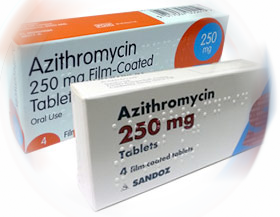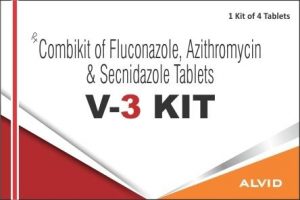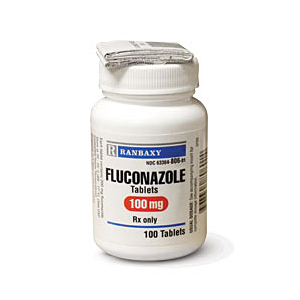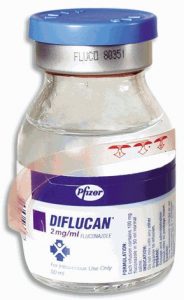Contents
What is Azithromycin?
Azithromycin is an antibiotic that is used for the treatment of variety of bacterial infections such as skin, ear, respiratory infections and sexually transmitted diseases (STDs).
The drug is available under generic name Azithromycin and marketed under the various brand names such as Zithromax, Azithrocin and Azyth. Pfizer is accountable for the manufacturing and marketing of Azithromycin. Furthermore, Azithromycin is marketed as an ophthalmic solution under the brand name AzaSite by Inspire Pharmaceuticals.
Azithromycin is a semi-synthetic, relatively broad spectrum, macrolide antibiotic. Azithromycin plays a key role in the treatment of complications related to the bacterial infections such as bronchitis, pneumonia, skin infections and infections of ear and throat. It is also recommended to treat the sexually transmitted diseases and urinary tract infections.
It is also used to prevent or treat the disseminated Mycobacterium avium complex (MAC) infection. Azithromycin (in form of ophthalmic solution) is used to treat bacterial conjunctivitis (a bacterial eye infection).
The drug is also prescribed for the treatment of acute bacterial sinusitis caused by H. influenza, M. catarrhalis or S. pneumonia. Sometimes, it is also used to treat the infection of H. pylori and Legionnaires’ disease (inflammatory lung infection caused by Legionella). It is also prescribed for the treatment of whooping cough. Azithromycin is a derivative of erythromycin and available as a dihydrate salt.
It is a semi-synthetic aliphatic heteromonocyclic antimicrobial agent with a molecular formula C38H72N2O12. The drug is a dihydrate salt of (2R,3S,4R,5R,8R,10R,11R,12S,13S,14R)-11-{[(2S,3R,4S,6R)-4-(dimethylamino)-3-hydroxy-6-methyloxan-2-yl]oxy}-2-ethyl-3,4,10-trihydroxy-13-{[(2R,4R,5S,6S)-5-hydroxy-4-methoxy-4,6-dimethyloxan-2-yl]oxy}-3,5,6,8,10,12,14-heptamethyl-1-oxa-6-azacyclopentadecan-15-one.
Azithromycin is available in tablet and oral suspension form for oral administration as well as in the form of ophthalmic solution. Azithromycin tablets are available in two different dosages of 250 mg and 500 mg, oral suspensions are available in two different dosages of 100 mg/5ml and 200 mg/5ml and both forms contain azithromycin dihydrate as active ingredient.
Azithromycin ophthalmic solution (AzaSite®) is available as 1% sterile solution which is an off-white viscous liquid. The dose of Azithromycin varies depending upon the age and diseased state of the patient.

What is Fluconazole?
Fluconazole is a widely known antifungal drug that is used to treat a variety of fungal infections, most notably Candida infections. The drug is effective against most of the Candida species (but not Candida glabrata or Candida krusei), some dimorphic fungi, Cryptococcus neoformans, and dermatophytes.
The medication is used to treat non-systemic Candida infections of the vagina (“yeast infections”), esophagus (tube leading from the mouth to the stomach), throat and abdomen (area between the chest and waist), mouth, and throat. The drug is also used to treat systemic Candida infections in people with healthy immune systems i.e. joints, kidney, blood stream infections.
Besides this, Fluconazole is also used to prevent Candida infections in people suffering with weak immune systems, such as neutropenic conditions due to advanced HIV infections, cancer chemotherapy, organ transplant, and premature babies. The medication is also used as a second-line treatment regimen for cryptococcal meningoencephalitis (fungal infection in the central nervous system).
Sometimes, Fluconazole is prescribed to treat serious fungal infections that begin in the lungs, eye, prostate (a male reproductive organ), skin and nails. The drug was developed by a group of scientists at Pfizer and was first marketed in 1990. The drug is on the World Health Organization’s List of Essential Medicines, the most important medications needed in a basic health system.
The medication is sold worldwide under generic name Fluconazole and various brand names such as Batén, Canesten, Candivast, Diflucan, Flucoral, Flavona, Flucanex 50, Fungican, Flucoder, Ibarin Monicure, Monistat, Triconal and Zocon. Fluconazole is the first generation triazole class of antifungal agent that structurally differs from other azole antifungals in which imidazole ring is replaced by a triazole ring.
Chemically, Fluconazole belongs to the class of organic compounds known as phenylpropylamines. The drug is chemically known as 2,4-Difluoro-1′,1′-bis(1H-1,2,4-triazol-1-ylmethyl) benzyl alcohol. The empirical formula and molecular weight of Fluconazole is C13H12F2N6O and 306.27 respectively. The most common route of administration of Fluconazole is via mouth or intravenously.
The drug is available in different forms such as powder, tablets, solution, transgel and eye drops. Fluconazole, USP is a white crystalline solid in appearance and slightly soluble in water and saline, while completely soluble in alcohol. The Fluconazole tablets for oral administration are available in different doses such as 50, 100, 150 and 200 mg of Fluconazole.
Besides Fluconazole as active ingredient, each tablet contains some other ingredient such as corn starch, colloidal silicon dioxide, croscarmellose sodium, magnesium stearate, microcrystalline cellulose, lactose monohydrate, and talc. Fluconazole USP is formulated in 0.9% sodium chloride solution, each 200 mg (100 mL bottle) containing 15 mmol each of Na+ and Cl–.
Pharmacokinetic studies with Fluconazole have revealed that the medication is completely absorbed within the two hours of consumption. Fluconazole follows elimination kinetics of zero order, where only 10% of the drug is eliminated due to metabolism, while the rest is being excreted through sweat and urine.
How Azithromycin and Fluconazole work?
Azithromycin is effective against gram positive bacteria such as Staphylococcus aureus, S. agalactiae, S. pneumonia and pyogenes, gram-negative bacteria such as Haemophilus ducreyi, H. influenza, Moraxella catarrhalis and Neisseria gonorrhoeae and some other bacteria like Chlamydophila pneumonia, Chlamydia trachomatis and Mycoplasma pneumonia.
Azithromycin is a macrolides antibiotic (such as Erythromycin and Carbomycin) which acts by inhibiting the bacterial protein synthesis, quorum-sensing and formation of bacterial biofilm. Macrolides primarily act through enhancing the dissociation of peptidyl-tRNA from ribosome, thus inhibiting transpeptidation and translocation step of protein synthesis (an intermediate steps of protein synthesis).
It has been observed that Azithromycin binds with the 50S subunit of ribosome and interferes with polypeptide synthesis. Therefore, it is predicted that stimulated dissociation of peptidyl-tRNA from ribosome is the major mechanism of action of Azithromycin. Azithromycin competes for [14C] erythromycin ribosome binding site, suggesting that it binds to the same receptor as erythromycin.
However, it does not affect the synthesis of nucleic acid. The Azithromycin accumulates at very higher concentration in cells, predominantly in phagocytes and therefore delivered effectively in high concentrations to sites of infection.
Fluconazole is a new subclass of synthetic triazole antifungal agents that is highly potent against yeast infections. The medication primarily works through reducing the growth of fungi that cause infection. Similar to other imidazole- and triazole-class antifungals Fluconazole also inhibits the cytochrome P450 enzyme 14α-demethylase.
In comparison to human and mammalian demethylase, fungal demethylase is highly sensitive to Fluconazole. The 14α-demethylase is primarily involved in cytochrome P450 enzyme conversion of lanosterol to 4,4-dimethylcholesta-8(9),14,24-trien-3β-ol. The inhibition of 14α-demethylase results in inhibition of lanosterol to ergosterol conversion.
Ergosterol is an essential part of the fungal cytoplasmic membrane and prevention of lanosterol to ergosterol conversion results in inadequate ergosterol and accumulation of 14α-methyl sterols. This results in inhibition or slowing the fungal growth i.e. fungistatic. Sometimes, Fluconazole also act as fungicidal in a dose-dependent manner (specifically Cryptococcus), however it depends upon organisms.
Ergosterol is an indispensable component of the fungal cell membrane and inhibition of ergosterol synthesis results in increased cellular permeability. This results in leakage of cellular contents and therefore adverse effect on cell growth and multiplication.
Besides this, other suggested mode of action of Fluconazole includes interaction with membrane phospholipids, inhibition of purine uptake, inhibition of endogenous respiration and transformation in to mycelial forms, and impaired triglyceride and/or phospholipid biosynthesis.
Can both Azithromycin and Fluconazole be taken together?
Yes, Azithromycin can be used in combination with Fluconazole. Open-label, randomized, clinical studies have shown that Fluconazole-Azithromycin combination (800 mg oral dose of Fluconazole and 1200 mg oral dose of Azithromycin) show insignificant pharmacokinetic interaction between Fluconazole and Azithromycin.
Both, Azithromycin and Fluconazole are available commercially in combination with Secnidazole. Both the drugs are reasonably effective and safe in the syndromic approach for lower genital infections.
Azithromycin and Fluconazole combination is also used for the treatment and/or prophylaxis of opportunistic infections in patients with AIDS. The usual prescribed dose for Azithromycin-Fluconazole combination is 150 mg Fluconazole and 250 mg Azithromycin.

Safety and precautions while taking Azithromycin: Fluconazole combination
- Azithromycin and Fluconazole may interact with other drugs. Therefore, care should be taken when you are taking any prescription or non-prescription medicines and herbal or vitamin supplements. It is advisable that you do not start, stop or change or take any medicine unless you have discussed with your doctor or professional consult.
- Do not use the medicine if you are hypersensitive or allergic (e.g., anaphylaxis) to Azithromycin or any other antibiotic such as Clarithromycin, Dirithromycin, Erythromycin and Ceftazidime or to similar antibiotics, such as Ceclor, Ceftin, Cefzil, Duricef, Keflex, Omnicef, Spectracef, Suprax, or any of the drug constituents.
- Do not share the medications with other persons having the similar kind of problems. Consult your doctor for more details.
- Azithromycin and Fluconazole are generally not recommended to be taken in case of pregnancy and breastfeeding
- Caution should be exercised with the use of Azithromycin oral solution and Fluconazole in diabetic patients.
- Azithromycin should not be used along with antacids as they bind to the Azithromycin and prevent the absorption in intestine.
- Before taking Azithromycin and Fluconazole, tell your doctor about your medical history if you have liver or kidney problem, blood infection and myasthenia gravis.
- Consult with your doctor if you have cystic fibrosis, irregular heartbeats, heart failure, infection of HIV and prolonged Qt intervals as some azoles including Fluconazole have been reported to be associated with prolongation of the QT interval on the electrocardiogram.
- Use of Fluconazole should be under supervision of doctors in patients with renal dysfunction.
- Fluconazole administration may occasionally account for dizziness or seizures, therefore alertness is necessary when driving vehicles or operating machines.
- Fluconazole solution is available as dilute saline solution and therefore caution should be taken while treating patients requiring sodium or fluid restriction.
“Can Azithromycin be taken with Ceftazidime?“
“Azithromycin oral and Rifampin oral Drug Interactions“
“difference between Nasonex and Flonase“




